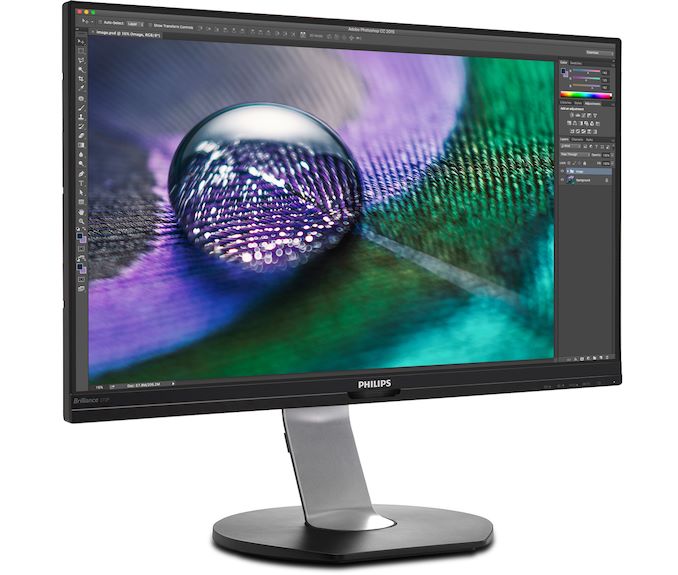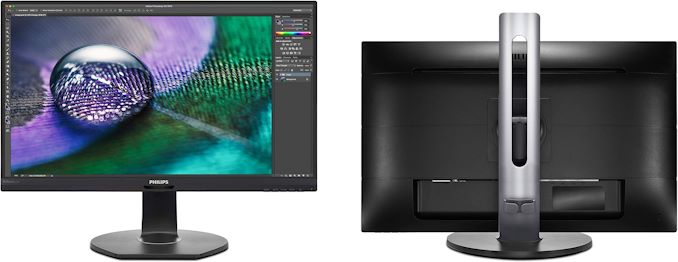Philips Brilliance 272P7VUBNB: A Sub-$350 27-Inch 4K IPS Monitor with 65W USB PD & GbE
by Anton Shilov on October 24, 2019 11:00 AM EST
In previous years monitor capabilities such as 4K resolutions, USB-C docking, and GbE connectivity have been premium features that have only been available in high-end monitors. However the price of all of those technologies is continuing to come down, and as such, those features are filtering down to increasingly mainstream monitors. To that end, Philips is launching its Brilliance 272P7VUBNB 4K display, a moderately priced 27-inch monitor with a USB 3.2 Gen 2 Type-C connector, a GbE port, and a PowerSensor that reduces its brightness when no user is present.
Designed primarily for office and productivity workloads, the Philips Brilliance 272P7VUBNB monitor uses a 27-inch IPS panel with a 3840×2160 resolution, 350 nits brightness, a 1000:1 contrast ratio, 178°/178° horizontal/vertical viewing angles, a 5 ms GtG response time, and a 60 Hz refresh rate. Since the LCD is not aimed at gamers or multimedia enthusiasts, it does not support a variable refresh rate technology and is not meant for HDR content. Nonetheless, it comes factory calibrated with a Delta E <2 accuracy, can display 1.07 billion colors, and reproduce 122% of the sRGB color gamut as well as 103% of the NTSC color gamut. Moreover, the panel has an 3H anti-glare coating, something that is valuable in office monitors.
The Brilliance 272P7VUBNB monitor comes equipped with a GbE port to provide Ethernet connectivity to laptops that do not have an appropriate adapter built-in. Since the GbE port is fed via USB, Phillips has decided to double-down on USB altogether, offering a USB-C input to connect upstream to a host machine and provide single-cable funcitonality. The display’s USB-C port can deliver up to 65 W of power to the host, which is enough for the majority of 13.3-inch and 14-inch mobile PCs. The USB upstream port is also used to feed a dual-port USB 3.2 Type-A hub.
Otherwise, a DisplayPort 1.2 input and an HDMI 2.0 port are also available so that the monitor can be used with older devices. The monitor also offers a headphone output, but no integrated speakers
Traditionally for Philips' P-series monitors, the Brilliance 272P7VUBNB comes equipped with the company's SmartErgoBase stand that can regulate height, tilt, swivel, and can enable both landscape and portrait modes, allowing the monitor to be positioned in numerous different ways.
| Specifications of Philips' 27-Inch 4K Docking Display | ||
| Brilliance 272P7VUBNB | ||
| Panel | 27" IPS | |
| Native Resolution | 3840 × 2160 | |
| Maximum Refresh Rate | 60 Hz | |
| Response Time (Grey-to-Grey) | 5 ms | |
| Brightness | 550 cd/m² | |
| Contrast | 1000:1 | |
| Viewing Angles | 178°/178° horizontal/vertical | |
| Pixel Pitch | 0.1557 × 0.1557 mm | |
| PPI | 163 | |
| Color Gamut | 122% sRGB 103% NTSC |
|
| Inputs | 1 × HDMI 2.0 1 × DisplayPort 1.2 1 × USB-C with 65 W Power Delivery |
|
| Stand | 3.5-mm headphone jack | |
| USB | Dual-port USB 3.0 hub | |
| GbE | RJ-45 connector | |
| PowerSensor | + | |
| Stand | Swivel: ±175° Tilt: -5 to +30° Pivot rotation: 90° Height: 150 mm |
|
| Power Consumption | Standby | 0.4 W |
| Typical | 23.5 W | |
| Maximum | ? W | |
The Philips Brilliance 272P7VUBNB carries an MSRP of $349.99, but it is now available at Amazon for $319.99.
Related Reading:
- Philips Reveals 346B1C 34-Inch 100 Hz Curved UltraWide Monitor with USB-C Docking
- HP’s E344c: A 34-Inch Curved Ultra-Wide Productivity Monitor
- Philips Brilliance 329P9H: A 4K IPS Monitor with USB-C Dock, GbE
- HP Unveils EliteDisplay E243d Docking Display with Webcam, GbE, & 65W Power Delivery
- Dell Announces Ultrathin S2719DC LCD: FreeSync USB-C with HDR600
Source: Philips












20 Comments
View All Comments
jeremyshaw - Thursday, October 24, 2019 - link
So is the USB-C capable of video input, as well? The addition of GbE is what's throwing me off, here.Given the other DP link is 1.2, that means all 4 lanes are needed for 4k60 (SDR). This means the GbE would be working off of USB 2.0, which we all know is 480Mbps. Or, the USB-C somehow supports DP1.4 (while the regular DP link strangely supports 1.2), so only two lanes are needed for 4k60, and the other two lanes can be reallocated for a bidirectional USB 3.0 link - more than enough for GbE.
Or, it is 480Mbps, and they don't care about the bottleneck (nor would is *really* matter, anyways).
jeremyshaw - Thursday, October 24, 2019 - link
I've taken a further look.I still don't have the answer as to the USB-C DP1.4/1.2, however, it does do USB-C DP-Alt mode. Based on the one amazon review of the monitor, I have to assume it uses USB 3.0 for its upstream data link, which leaves only two lanes for DP. Given the manual wasn't too helpful, I was only able to glean that Phillips expects the USB-C input to be capable of 4k60 as well. This most likely means DP1.4 in the DP-Alt mode.
Good luck, 99% of Intel-based laptops with DP1.2. A good number of the Ryzen laptops aren't in the clear, either, but most should support DP1.4 (hopefully via USB-C DP-Alt mode; it's supported in HW, but not all board vendors or laptop ODMs actually implement the circuitry to output DP1.4 HBR3 signals, and they are stuck with HBR2).
jeremyshaw - Thursday, October 24, 2019 - link
If all of this is true, given the color gamut and resolution, I think it should be a better overall deal than the Lenovo P27h USB-C monitor, barring any serious difference in other panel qualities.GreenReaper - Thursday, October 24, 2019 - link
Perhaps so, though be aware it's an 8-bit panel with FRC to achieve 10-bit output. (For most people this should be fine, and will be less noticeable than 6-bit FRC for 8-bit colour.)GreenReaper - Thursday, October 24, 2019 - link
USB-C's specification for DP includes DisplayPort 1.4.https://en.wikipedia.org/wiki/USB-C#Alternate_Mode...
https://www.anandtech.com/show/8558/displayport-al...
I am not entirely sure if a compliant device *must* support 1.4, but that is the only solution I can see that gives it HBM3 and therefore only requires one lane for display information at this resolution. Though, is this necessary? There are four lanes, you use one for upstream, one for downstream... Can you use the two other streams together? I guess Multi-Stream Transport doesn't help here...
It is possible to switch it to USB 2.0 mode from 3.2 mode, however unlike the ultrawide Phillips we saw recently, this is *not* called out in the manual as necessary for full Ethernet performance at full resolution and refresh rate.
According to its specification, available on its website and in the user manual, the monitor uses USB-C 3.2 Gen2 x1 port for the display signal. It also claims to offer USB–C3.2 Gen2 x 1 port (upstream; the same port as the signal) and separately USB3.2 x 2 ports (downstream, 1 w/fast charging).
https://www.usa.philips.com/c-p/272P7VUBNB_27/bril...
mdrejhon - Thursday, October 24, 2019 - link
I prefer a really good gaming monitor, but you can’t believe how many boilerplate 1080p 60Hz 72%-gamut monitors sit on office desks at cubicle farms.Instead of Generic ACMEtron 60Hz (Or a cheap DELL or HP office monitor), I’ll happily PhotoShop or VisualStudio on this baby any day, even if I miss out on the beauty of 144Hz and 240Hz at my home.
We need this monitor to be the new lowest common denominator. Raise the bar!!
imaheadcase - Thursday, October 24, 2019 - link
They sit like that because they get discount to buy in bulk. No company is going to raise the bar, when the lowest bar just works for basic tasks.sorten - Thursday, October 24, 2019 - link
HDMI 2.0 and DP 1.2? I guess controllers from 2013 are so inexpensive that manufacturers can't pass them up?GreenReaper - Thursday, October 24, 2019 - link
If it meets the requirements of the panel, why pay (or require) more? This isn't the latest and greatest; it's a mass-market device and priced accordingly. May also help keep power usage down.timecop1818 - Thursday, October 24, 2019 - link
> Brilliance 272P7VUBNB monitor uses a 27-inch IPS panel with a 3840×2160 resolution, 350 nits brightnessThen below table lists:
> Brightness 550 cd/m²
So which number is correct?